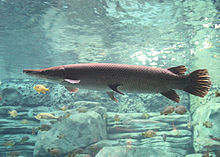Atractosteus
| Atractosteus | |
|---|---|

| |
| Alligator gar | |
| Scientific classification | |
| Domain: | Eukaryota |
| Kingdom: | Animalia |
| Phylum: | Chordata |
| Class: | Actinopterygii |
| Clade: | Ginglymodi |
| Order: | Lepisosteiformes |
| Family: | Lepisosteidae |
| Genus: | Atractosteus (Rafinesque, 1820) |
| Type species | |
| Esox spatula Lacépède, 1803
| |
| Species | |
|
See text | |
| Synonyms[2][3] | |
| |

Atractosteus is a genus of gars in the family Lepisosteidae, with three extant species. It is one of two surviving gar genera alongside Lepisosteus.[4]
The three surviving species are all widely separated from one another, with A. spatula being found in the south-central United States, A. tropicus in southern Mexico and Central America, and A. tristoechus in Cuba.[4] Although generally inhabiting fresh water, they are tolerant of marine conditions.
Evolution
[edit]The genus first appeared during the Santonian stage of the Late Cretaceous, having diverged from Lepisosteus earlier in the Cretaceous.[4] It quickly achieved a widespread distribution throughout the rest of the Cretaceous, being known from North America, South America and Europe.[5][6] Atractosteus survived the Cretaceous-Paleogene extinction event, with one articulated fossil of the species A. grandei being recovered from strata dated to just a few thousand years after the extinction event, making it the oldest known articulated vertebrate fossil from the Cenozoic.[7] It was found throughout North America and Europe during the Paleogene, but by the Neogene this had shrunk to only certain parts of North America, where it is still found today.[4]
Systematics
[edit]Species
[edit]Extant species
[edit]| Image | Scientific name | Common name | Distribution |
|---|---|---|---|
 |
Atractosteus spatula Lacépède, 1803 | Alligator gar | Southern United States |
 |
Atractosteus tristoechus Bloch & J. G. Schneider, 1801 | Cuban gar | Western Cuba and the Isla de la Juventud |
 |
Atractosteus tropicus T. N. Gill, 1863 | Tropical gar | Southern Mexico to Costa Rica |
Fossils
[edit]- †"Atractosteus" africanus (Arambourg & Joleaud, 1943)[8] (placement in Atractosteus disputed)
- †Atractosteus atrox (Leidy, 1873)
- †Atractosteus grandei Brownstein & Lyson, 2022[9]
- †Atractosteus emmonsi Hay 1929
- †Atractosteus lapidosus Hay 1919
- †Atractosteus messelensis Grande 2010
- †Atractosteus occidentalis (Leidy 1856) non Wiley 1976
- †Atractosteus simplex (Leidy 1873)
Former fossil genera:
- †Atractosteus cuneatus (Cope 1884) non (Cope 1878) (now in Cuneatus)
- †Atractosteus falipoui (Cavin & Brito 2001) (now in Oniichthys)
References
[edit]- ^ Szabó, M.; Gulyás, P.; Ősi, A. (2016). "Late Cretaceous (Santonian) Atractosteus (Actinopterygii, Lepisosteidae) remains from Hungary (Iharkút, Bakony Mountains)". Cretaceous Research: 239–252. doi:10.1016/j.cretres.2015.12.002.
- ^ Froese, R.; Pauly, D. (2017). "Lepisosteidae". FishBase version (02/2017). Retrieved 18 May 2017.
- ^ Van Der Laan, Richard; Eschmeyer, William N.; Fricke, Ronald (11 November 2014). "Family-group names of Recent fishes". Zootaxa. 3882 (1): 1–230. doi:10.11646/zootaxa.3882.1.1. PMID 25543675.
- ^ a b c d Doran Brownstein, Chase; Yang, Liandong; Friedman, Matt; Near, Thomas J (2022-12-20). "Phylogenomics of the Ancient and Species-Depauperate Gars Tracks 150 Million Years of Continental Fragmentation in the Northern Hemisphere". Systematic Biology. 72 (1): 213–227. doi:10.1093/sysbio/syac080. ISSN 1063-5157.
- ^ Alves, Yuri Modesto; Montefeltro, Felipe Chinaglia; Cidade, Giovanne M. (2021-05-01). "New occurrences of Atractosteus (Ginglymodi: Lepisosteoidea: Lepisosteidae) from the Bauru Group (Upper Cretaceous, Brazil) and paleobiogeographic implications". Cretaceous Research. 121: 104735. doi:10.1016/j.cretres.2020.104735. ISSN 0195-6671.
- ^ Szabó, Márton; Gulyás, Péter; Ősi, Attila (2016-05-01). "Late Cretaceous (Santonian) Atractosteus (Actinopterygii, Lepisosteidae) remains from Hungary (Iharkút, Bakony Mountains)". Cretaceous Research. 60: 239–252. doi:10.1016/j.cretres.2015.12.002. ISSN 0195-6671.
- ^ Brownstein, Chase Doran; Lyson, Tyler R. (2022). "Giant gar from directly above the Cretaceous–Palaeogene boundary suggests healthy freshwater ecosystems existed within thousands of years of the asteroid impact". Biology Letters. 18 (6). doi:10.1098/rsbl.2022.0118. ISSN 1744-957X. PMC 9198771. PMID 35702983.
- ^ Cavin, Lionel; Martin, Michel; Valentin, Xavier (1996). "Occurrence of Atractosteus africanus (actinopterygii, lepisosteidae) in the early Campanien of Ventabren (Bouches-du-Rhône, France). Paleobiogeographical implications". Revue de Paléobiologie. 15 (1): 1–7.
- ^ Brownstein, Chase Doran; Lyson, Tyler R. (2022). "Giant gar from directly above the Cretaceous–Palaeogene boundary suggests healthy freshwater ecosystems existed within thousands of years of the asteroid impact". Biology Letters. 18 (6): 20220118. doi:10.1098/rsbl.2022.0118. PMC 9198771. PMID 35702983.
- Froese, Rainer; Pauly, Daniel (eds.). "Species in genus Atractosteus". FishBase. June 2011 version.

